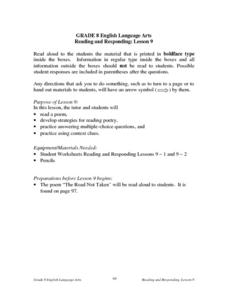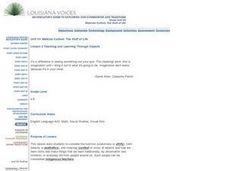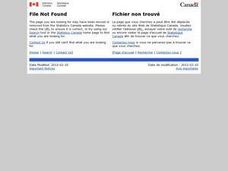EngageNY
Relationships Between Key Scientific Concepts: What Causes Hurricanes?
A storm is brewing in the sea. Scholars complete multiple reads of How Does a Hurricane Form to determine gist, cause-and-effect relationships, and deepen vocabulary understanding. To finish, they complete graphic organizers...
Curated OER
Dos mapas de Florida, el Caribe y parte de Sur America
What can maps tell us about the past? Find out with a Spanish lesson that incorporates geography. After examining maps individually, comparing two old maps of Spanish Florida and writing notes in the provided Venn diagram, pupils pair up...
National Park Service
A Tale of Two Men
Theodore Roosevelt and the Marquis de Mores were both born in 1858, and both came to the Dakota territory in 1883, but they influenced the developing country of America in different ways. Elementary and middle schoolers apply written and...
Curated OER
What Can I Do?
Young scholars identify how they are feeling and deal with feelings constructively. In this conflict resolution lesson, students explore their feelings through discussion. Young scholars read and complete the What Can I Do? e-sheet....
Curated OER
Taking a picture Walk
First graders use question words to answer comprehension questions. In this reading strategies activity, 1st graders use picture cues and predict events in a story. Students use context clues to understand unfamiliar words....
Curated OER
Electrifying Franklin
Fourth graders research and present information about Benjamin Franklin's life and accomplishments. In this instructional activity on Benjamin Franklin, 4th graders review idioms and sayings written by Franklin then compare and contrast...
Curated OER
Artifacts 2: Artifacts in Context
Students will explore an archaeological mystery that demonstrates the importance of context in learning from artifacts. Factors such as the artifact's location, its proximity to other artifacts, and the number of similar artifacts found...
Macmillan Education
The Tell-Tale Heart
Rather than who done it, the mystery literary detectives have to solve as they examine the evidence found in Edgar Allan Poe's famous "The Tell-Tale Heart" is why did he do it?
Curated OER
Introducing Synonyms to Early Writers
Upper elementary schoolers examine the concept of synonyms and how using a variety of vocabulary through synonyms can expand their writing skills. They revise a paragraph using synonyms located on the Visual Thesaurus and participate in...
Curated OER
Random Acts of Kindness For Kids
Develop a world-wide, email chain on which class members can showcase their acts of kindness. After defining the meaning of random acts of kindness through discussion and through a reading of Random Acts of Kindness,...
Curated OER
Reading And Responding: Lesson 4 Nonfiction/test-taking Strategies
Eighth graders participate in a teacher led activity that focuses on reading nonfiction and test taking strategies. They examine the use of context clues to improve their vocabulary and summarization skills. Also, they complete the...
Curated OER
Reading And Responding: Lesson 15 Nonfiction
Eighth graders examine a nonfiction selection in a teacher led lesson plan. They examine the author's purpose for writing the selection and identify the difference between fact and opinion. The compare and contrast expository and...
Curated OER
Reading and Responding: Lesson 9
Eighth graders listen to a read aloud of Robert Frost's poem "The Road Not Taken." They examine the attributes of poetry focusing on stanzas, imagery, and punctuation. They participate in choral readings before completing the associated...
Curated OER
Esperanza Rising: Lesson 3
Sixth graders read parts of the book Esperanza Rising and define vocabulary words connected to it. In this Esperanza Rising lesson plan, 6th graders illustrate words and discuss the sections of the books they read.
Curated OER
Rollin’ on the River: Identifying Jargon
Students identify jargon in poetry, prose and fiction. In this literature lesson, students will read selections from Mark Twain and identify figurative langauge, focusing on jargon.
Curated OER
Teaching and Learning Through Objects
Students identify and interpret the function, usefulness or utitlity, form, beauty or aesthetics, and meaning, context or story, of objects and how they learn new skills and make things that they learn traditionally, by observation and...
Curated OER
Native American Culture
Students read a variety of Native American Literature and discuss the main idea by answering critical thinking questions about the poem. Students use context clues to understand the feeling of the Native American culture about the Earth....
Curated OER
Using the News in Class
Students listen to international news stories. Students use context clues to determine the meaning of vocabulary words from context, then complete a matching exercise to see if their vocabulary definitions were correct. Students...
Curated OER
There's Omegas in Those Hemp Seeds
A very well-designed lesson plan focuses on the many benefits of Omega Fatty Acids. Learners read some articles on omega fatty acids, then access a glossary that is included in the plan. They fill in terms along with their definitions....
Curated OER
Letters From Rifka
Small groups read assigned chapters from the book, Letters to Rifka, then work together to fill out comprehension worksheets associated with their chapters. This fine, 13-page lesson culminates with each group getting together to meet...
Curated OER
Location, Location, Location: Using a Grid to Determine Context
Seventh graders are introduced to making inferences about artifacts. Using a grid system, they locate the artifacts and determine where they originated from. They use this information to make conclusions about the way people lived...
Curated OER
Inquiry Lesson
Students explore the poetry of William Blake and the historical context that he presents. A story is analyzed and evaluated in order to solve a puzzle. The political commentary of the poetic piece is examined in this instructional activity.
Curated OER
Character in a Box
Partners choose, research, and analyze fictional or historical characters and design character life boxes to represent them. They also compose a rhyme royal, which they understand inductively by deconstructing examples. Based largely on...























